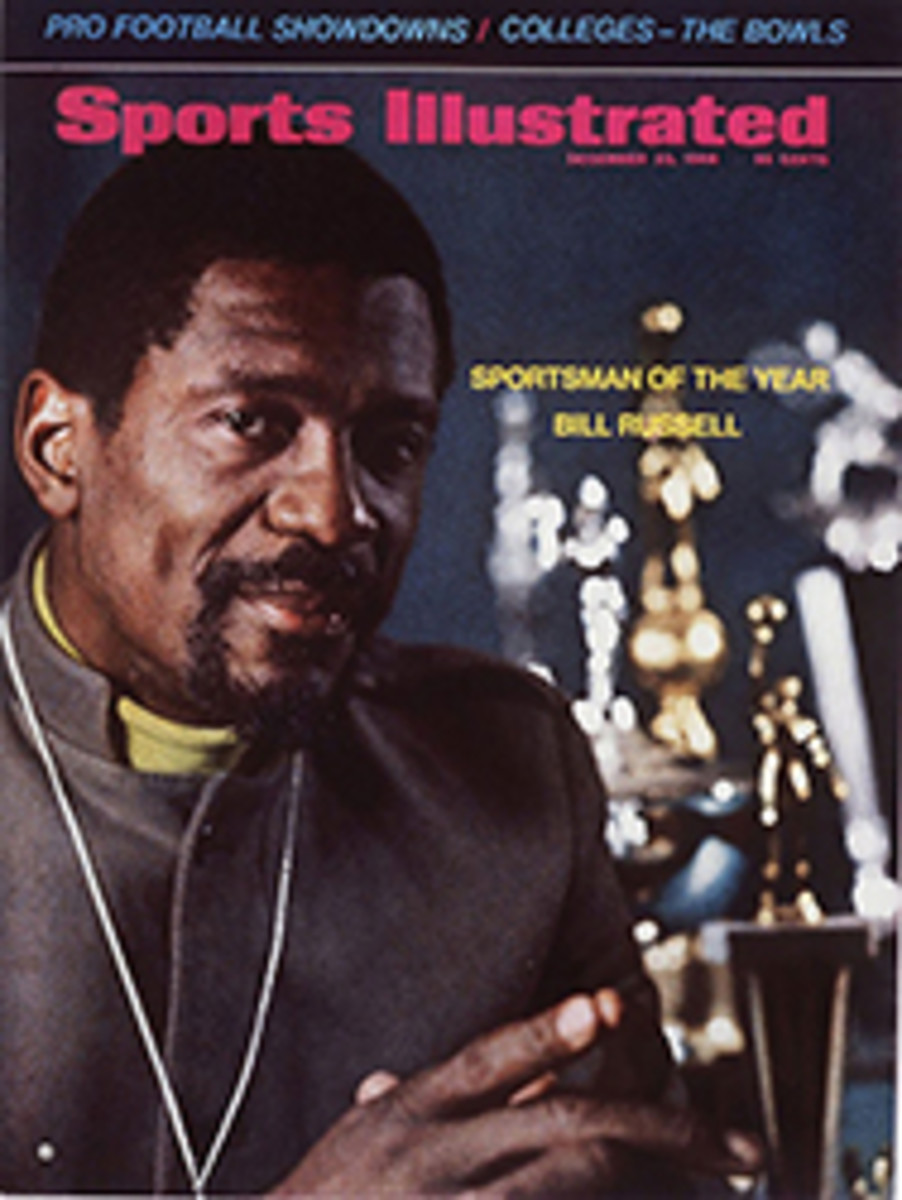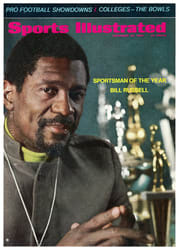
Ben-Hur Played the Rose Bowl
The annual Rose Bowl football game is what the TV boys like to call "the granddaddy of them all"—the most celebrated of all New Year's Day classics. But there was a time, right in the beginning, when football almost ruined Pasadena's famed Tournament of Roses. What saved it was chariot racing!
The purpose of having an athletic contest at all was simply to provide a sort of grand climax to a round of parties and parades, but in the first football game at the bowl in 1902 Michigan polished off Stanford 49-0, spoiling the whole day for the local fans. Polo was tried for a year, but that proved an even greater disaster than football. It was far too recondite and refined for the Californians. What they wanted was something simple yet sanguinary, and these were exactly the qualities the committee found in General Lew Wallace's novel about chariot racing.
Today everybody knows about Ben-Hur, lover, statesman, patriot and, most famously, the daring chariot driver who was to prove the ideal for generations of New York cab drivers. His triumph came one day at the Circus in Antioch when, in a wheel-to-wheel duel with a villain named Messala, old Ben's chariot collided with Messala's. Messala was thrown under his chariot, and his horses proceeded to drag him around the track, stripping him of much valuable hide and perfectly delighting all Romans out to gladden their hearts with a good bloodletting. All this had been suddenly brought to new light in a Broadway play—so, thought the Rose committee, what's good for New York and Antioch just might be good for Southern California. So why not a chariot race? That's how it came to be that on New Year's Day 1904 two men donned togas and headbands, fixed their chariots behind two teams of four horses each and, with a nod to history, set out before all their neighbors to decide the championship of the first annual Tournament of Roses chariot race.
One of the racers that day was a member of the tournament committee, Ed Off by name, a novice horseman who was destined to be remembered as chariot racing's Man of La Mancha. The other, a thin man with a modest mustache and an honest-to-goodness Bat Masterson cane with a gold knob, had been around horses all his life. His name was Mack Wiggins, the second son of a Big Valley sort of family that was more or less typical of the hard-working, hard-drinking, hard-playing people who lived around Pasadena.
Mack's forefathers were from Kentucky, where his maternal grandfather did Daniel Boone things like wrestling bears. His father, T.J. Wiggins, and his mother, the former Ellen Vise, had gone West in covered wagons and finally settled in El Monte, where they took up farming and rearing children. The children—three of them, anyway—took up chariot racing long before the bowl committee thought of it.
The protocol of American chariot racing at the turn of the century called for the competitors to circle the track at least once to the tune of a drum roll, finally moving side by side as they passed the starting line. Once the race began it was every man for himself. Sometimes the chariots locked wheels, Ben-Hur style, as they battled around the track. In one race a horse died when the tongue of a chariot broke and plunged through his chest. "They drove 'em just like the Romans used to," recalls Mack Wiggins' nephew Edwin, who still lives in El Monte, Calif.
By the time Mack Wiggins and Ed Off started their Rose festival circling at the old Tournament Park (now the site of the more prosaic California Institute of Technology), the crowd had swelled to an estimated 6,500, more than three times the number that had watched polo the year before.
"Everybody bet," says Edwin Wiggins. "And remember, a dollar meant a lot in those days." Those who backed Off went home broke. Showing the form and skill he had developed in lesser races at San Bernardino and El Monte, Wiggins charged home an easy winner, to become the first Rose Bowl Chariot Champion.
But the quixotic Off was back to try again the following year. The race was momentarily delayed while gopher holes in the track were filled. Came race time, Off took an early lead over hotel man D.M. Linnard, but he soon lost control of his team and had to hang on for dear life. When his rampaging horses finally were brought under control, Off staggered out of his chariot and reeled up to take a bow before the first Rose Queen, Hallie Woods. Just then his rubbery legs gave way, and Off fell flat on his face before Her Majesty.
Undaunted, the redoubtable Off was back at it still another year. This time he again lost control of his team, which continued unchecked after passing the finish line. Off was unceremoniously dumped when one horse fell, upsetting the chariot. Unfortunately he incurred injuries serious enough to force his retirement from a sport for which he had never shown any great aptitude.
The winner that year (1906) was a hired hand named C.C. West. He wore a long, flowing cloak decorated with the Maltese cross of famed sportsman Lucky Baldwin. His win was a victory for professionalism, but the beginning of the end for Tournament of Roses chariot racing.
As early as 1909—although attendance reached 20,000, indicating that interest was high—it was apparent that Pasadena's chariot races were dying a slow death. Horse racing had recently been banned in California, making it difficult to find fast horses capable of pulling a chariot. Then, too, the cost had become so prohibitive—an estimated $5,000 to train a team for just one day's racing—that few besides Lucky Baldwin could afford it.
Baldwin was a swashbuckler, a stocky man with a mustache, known widely as the King of the Valley. His fortune had been made in the gold and silver fields, and now it was manifested in all sorts of extravagances: a private winery, a private train, even a private racetrack. Santa Anita was once Baldwin's Santa Anita ranch. Neroesque entertainment like chariot racing was Baldwin's bag. He hired a driver, West, and put a wad of money into a fine team of horses. Bringing over a party of friends each New Year's Day, Baldwin watched his team win first in 1906, then again in 1908 after a rival driver was disqualified. By 1909 he had so cornered the market and cowed the opposition that only one challenger appeared. That one was flicked off in a breeze.
Interest waned to such a degree that in 1913, in a revival effort, the tournament committee added an ostrich race and a race between a camel and an elephant to the show, but it didn't help. Death of the competition was assured in 1915, when the ill-starred Ed Off made the mistake of declaring it immortal. "Pasadena is now the recognized home of chariot racing", said Ed in his kiss of death. "The sport, as presented here, appeals strongly to the crowds." That year the Tournament of Roses sponsored its last chariot race. "The horse-and-buggy days were just about over," says Edwin Wiggins. "People were turning to the automobile."
By then Stanford's 49-0 humiliation at the hands of Michigan was all but forgotten. The young people growing up around Pasadena were either less robust than their elders or more inclined to want their sport on a sophisticated level. In any case, football staged a comeback in 1916 and a triumphant one, at that. Washington State beat Brown 14-0 in a pouring rain, and stories of the game were carried in almost every major newspaper in the country. With the nation's attention riveted on Pasadena, football and the Tournament of Roses formed a union that has endured to this day.
Meanwhile the center of chariot racing gravitated north to Pocatello, Idaho, where the world series of chariot racing is still held every year. Last March 104 two-horse chariot teams competed in four divisions, and about 5,000 of the city's 42,000 population attended. Of course, times have changed. An average chariot today might be made from a 50-gallon oil drum and Honda tires. Whatever the material, it's still chariot racing and you know that somewhere the Wiggins brothers and Ed Off are smiling and nodding approvingly.

